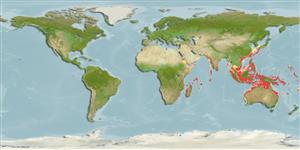>
Eupercaria/misc (Various families in series Eupercaria) >
Labridae (Wrasses)
Etymology: Leptojulis: Greek, leptos = thin + Greek, ioulis, a fish dealing with genera Coris or Thalassoma (Ref. 45335).
More on author: Bleeker.
Environment: milieu / climate zone / depth range / distribution range
Écologie
marin récifal; profondeur 4 - 75 m (Ref. 90102). Tropical
Indo-West Pacific: Gulf of Oman to the Philippines and Australia.
Taille / Poids / Âge
Maturity: Lm ? range ? - ? cm
Max length : 13.0 cm TL mâle / non sexé; (Ref. 2334)
Épines dorsales (Total) : 9; Rayons mous dorsaux (Total) : 11; Épines anales: 3; Rayons mous anaux: 11 - 12. Slender species, usually with brown or dusky mid-lateral stripe. Male with reflective blue spot in the dark band, just past pectoral fin (Ref. 48636).
Found in clear coastal slopes to outer reef lagoons on open rubble patches or rocky bottom (Ref. 48636). Occurs in groups (mostly females) on or near reefs, usually where the water is somewhat turbid and rich in plankton. Fish in the initial phase are much more abundant than the terminal males. Feeds on zooplankton at least a meter above the substrate.
Life cycle and mating behavior
Maturité | Reproduction | Frai | Œufs | Fécondité | Larves
Oviparous, distinct pairing during breeding (Ref. 205).
Randall, J.E., 1996. Second revision of the labrid fish genus Leptojulis, with descriptions of two new species. Indo-Pac. Fish. (24):20 p. (Ref. 12420)
Statut dans la liste rouge de l'IUCN (Ref. 130435: Version 2024-1)
Menace pour l'homme
Harmless
Utilisations par l'homme
Pêcheries: intérêt commercial mineur; Aquarium: Commercial
Outils
Articles particuliers
Télécharger en XML
Sources Internet
Estimates based on models
Preferred temperature (Ref.
123201): 24.3 - 29, mean 28 °C (based on 1360 cells).
Phylogenetic diversity index (Ref.
82804): PD
50 = 0.5312 [Uniqueness, from 0.5 = low to 2.0 = high].
Bayesian length-weight: a=0.00977 (0.00470 - 0.02030), b=3.07 (2.90 - 3.24), in cm total length, based on LWR estimates for this (Sub)family-body shape (Ref.
93245).
Niveau trophique (Ref.
69278): 3.4 ±0.45 se; based on food items.
Résilience (Ref.
120179): Haut, temps minimum de doublement de population inférieur à 15 mois (Preliminary K or Fecundity.).
Fishing Vulnerability (Ref.
59153): Low vulnerability (10 of 100).
Nutrients (Ref.
124155): Calcium = 94.5 [55.1, 175.1] mg/100g; Iron = 0.878 [0.502, 1.658] mg/100g; Protein = 18.2 [15.3, 20.4] %; Omega3 = 0.172 [0.102, 0.286] g/100g; Selenium = 27.1 [15.1, 52.2] μg/100g; VitaminA = 222 [67, 805] μg/100g; Zinc = 1.66 [1.11, 2.61] mg/100g (wet weight);
